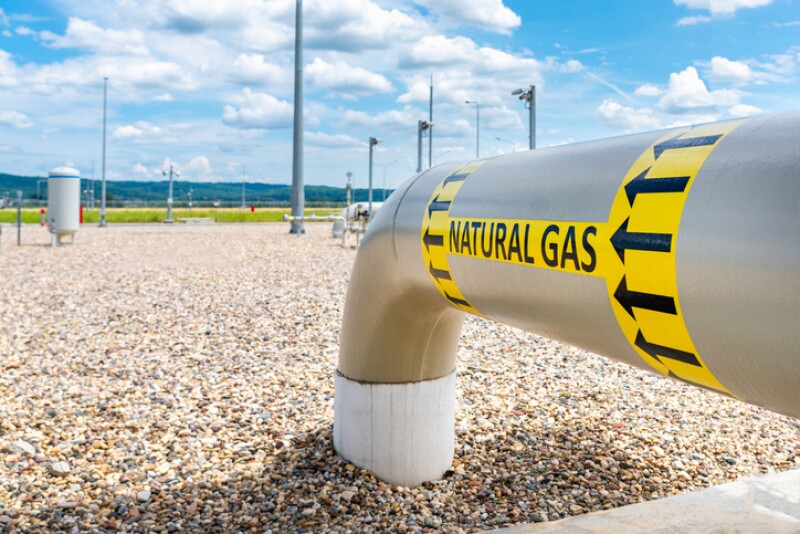The concept that natural gas serves as a "bridge fuel" has dominated the energy transition debate for years. On one side of the discussion, it is introduced as a necessary step toward a low-carbon future, providing a cleaner alternative to coal and oil while renewable energy technologies mature. On the other side, the approach of continuous reliance on natural gas is criticized because it may further fossil fuel dependency and undermine long-term climate goals, particularly due to methane (CH4) leaks that may negate any climate benefits.
As the urgency to curb greenhouse gas emissions intensifies, it is essential to examine whether natural gas is genuinely a transitional solution or a roadblock to a sustainable future.
The concept of natural gas as a bridge fuel gained traction in the early 2000s with the rise of shale gas (natural gas extracted from sedimentary rock using fracturing) in the US. This was largely driven by technological advancements in hydraulic fracturing and horizontal drilling, making gas extraction more economically viable. The primary argument for its role as a bridge fuel is that it emits less carbon dioxide (CO₂) than coal.
Historical Framework
Historical energy transitions typically involved a gradual shift from one dominant fuel source to another. Coal overtook biomass in the 19th century, followed by the rise of oil and natural gas in the 20th century. Unlike past transitions, however, the shift toward renewable energy is constrained by urgent climate goals and is more contentious, especially given the recommendation by the Intergovernmental Panel on Climate Change (IPCC) to cut global emissions by nearly 50% by 2030.
In the 1970s, natural gas was considered a cleaner alternative amid concerns about oil dependence. Several countries expanded their gas infrastructure significantly, reducing their reliance on coal. However, as concerns over methane emissions grew, the sustainability of this approach has been increasingly questioned.
Production and Utilization of Natural Gas
To consider natural gas a bridge fuel in the energy transition, it is important to examine the global increase in gas production relative to oil. As seen in Figs. 1 and 2, over the past 3 decades, natural gas production has more than doubled, while oil production has increased about 45%.
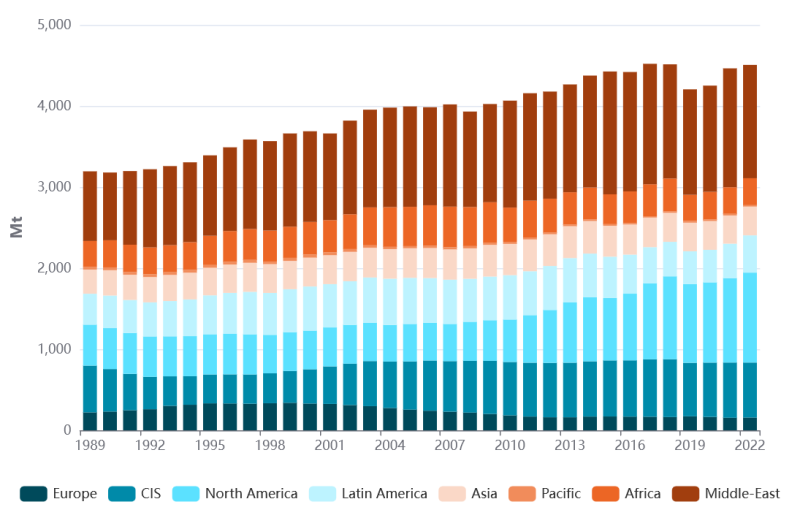
This result was primarily driven by a common strategy of investments, involving both oil and gas companies and government. In the early 1990s, gas was not considered a valuable product due to limited availability of midstream infrastructure. Associated-gas production was mainly flared, contributing to air pollution.
Since the 2000s, paying more attention to the environment, both upstream companies and governments invested more in natural gas facilities, introducing gas pipelines and LNG floating points. This allowed the Middle East, Asia, Africa, and Pacific areas to boost their gas production.
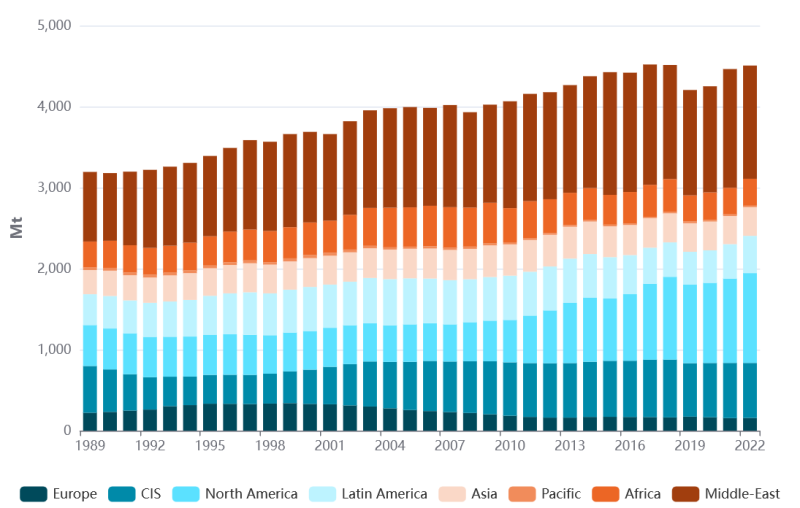
In 2022, the upward trend saw a sharp slowdown due to Russia’s invasion of Ukraine. In response, the EU imposed severe sanctions on Russian exports, prompting many European countries to gradually cut their natural gas imports from Russia. Before the conflict, Russian gas accounted for more than 40% of Europe's supply, but this share dropped to just 11% following the escalation (European Council, 2025).
Emission Footprint and Infrastructure Lock-In
While natural gas produces fewer CO2 emissions than coal, its climate impact is complicatedcomplexed by methane leaks. The concentration of methane in the atmosphere is now more than 2.5 times higher than pre-industrial levels, with the rate of increase accelerating in recent years. Methane, the primary component of natural gas, is a potent greenhouse gas with a global warming potential 28 times greater than CO2 over a 100-year period.
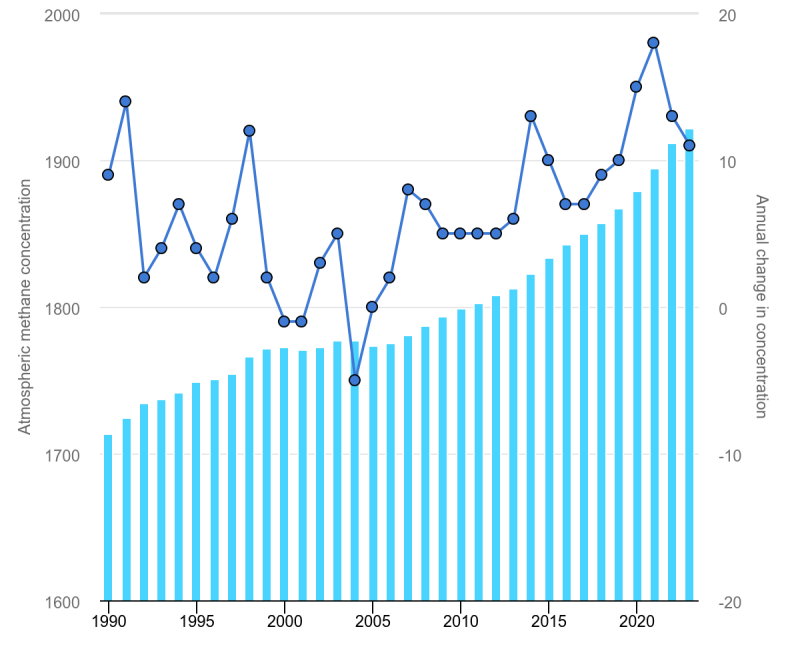
While methane has a significantly higher global warming potential than CO2, it also has a 12 year-shorter atmospheric lifetime (Fig. 3). This makes rapid methane reduction one of the most effective strategies for slowing near-term climate change.
Several studies and reports suggest that methane emissions from the oil and gas industry are significantly underestimated, potentially negating the benefits of fuel switching. Both satellite and model-based estimations for oil and gas operations, one of the largest sources of methane in the US, were higher than EPA’s estimates by 12% (NASA, 2024).
Investments in natural gas infrastructure, such as pipelines and LNG terminals, have long lifespans (30 to 50 years), raising concerns that these assets could become "stranded" if the world transitions to low-carbon energy more rapidly than anticipated. The Carbon Tracker Initiative warns that nearly half of the capital invested (approximately $1 trillion) in new gas projects by 2030 could be stranded, becoming nearly obsolete to alternative energy sources, if governments adhere to their net-zero commitments (Fig. 4).
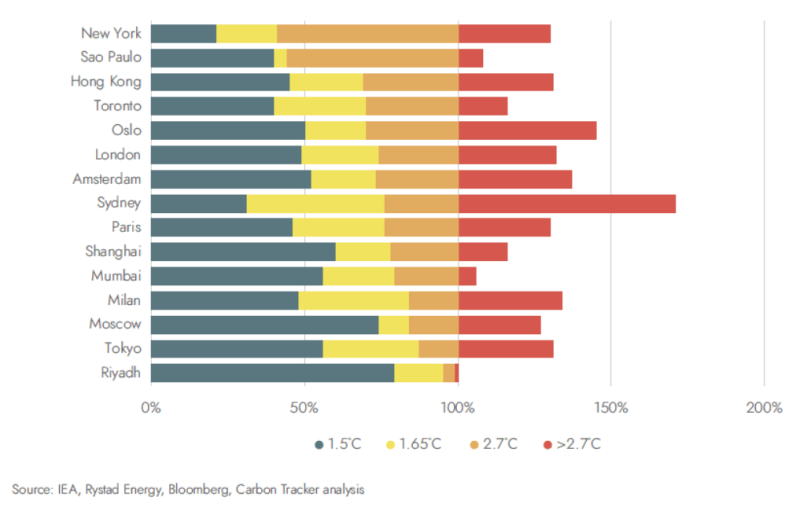
Environmental Impact
As highlighted above, the benefits of natural gas are often weighed against its drawbacks from an environmental point of view.
Benefits of Natural Gas
1. Lower CO2 emissions: Compared to coal, natural gas combustion emits about half the CO2 per unit of energy produced. For example, coal emits approximately 205.7 to 228.6 pounds of CO2 per MMBtu, whereas natural gas emits about 117 pounds per MMBtu.
2. Grid reliability: Natural gas plants provide reliable and stable power, making them a valuable complement to intermittent renewable sources like solar and wind by helping maintain grid stability. Although natural gas is non-renewable, its abundant reserves offer a more consistent energy supply than renewables alone.
3. Reduced local pollution: Natural gas combustion typically produces lower levels of pollutants such as sulfur dioxide (SO2), nitrogen oxides (NOX), and particulate matter, resulting in less air pollution compared to other fossil fuels. This is partly because natural gas is often processed to remove impurities, achieving high purity before combustion.
Drawbacks of Natural Gas
1. Methane leakage: Even small leaks from extraction, processing, and transportation can significantly contribute to climate change. Methane leakage rates as low as 2% can negate the climate benefits of natural gas over coal.
2. Delayed transition: Continued reliance on gas could slow down investments in wind, solar, and storage technologies.
3. Water and land use: Hydraulic fracturing can lead to groundwater contamination and increased seismic activity in some regions.
Conclusion: Bridge or Roadblock?
While natural gas has played a vital role in displacing coal and supporting renewable integration, its continued expansion as a bridge fuel must be approached with caution. The environmental case for new gas infrastructure is increasingly complex. While it can reduce emissions relative to more polluting fuels like coal, and in certain scenarios, it may provide essential services—such as seasonal energy storage, industrial high-temperature heat, and peak winter heating—that are not yet cost-effectively met by low-carbon alternatives. On the other hand, there is a real risk of carbon lock-in, where new gas-related investments perpetuate long-term emissions unless mitigated by widespread deployment of carbon capture, utilization, and storage (CCUS) technologies.
The future role of gas in the energy transition hinges on context-specific evaluations, policy frameworks that incentivize decarbonization, and robust investment in CCUS.
For Further Reading
The Evidence is Clear: The Time for Action is Now. We Can Halve Emissions by 2030. Intergovernmental Panel on Climate Change.
Understanding Methane Emissions, IEA.
Importance of Methane, EPA.
Energy Transition and Geoeconomic Fragmentation: Implications for Climate Scenario Design by C. Gardes-Landolfini, P. Grippa, W. Oman, and S. Yu.
Unburnable Carbon: 10 Years On by T. Allen and M. Coffin, Carbon Tracker Initiative.
How Much Carbon Dioxide Is Produced When Different Fuels are Burned? American Geosciences Institute.
Reality Check: Natural Gas’s True Climate Risk by D. Gordon and S. Hughes.
Satellite Data Suggest US Methane Emissions Underestimated, NASA.

Bhartendu Bhardwaj is a reservoir engineer at Bassein & Satellite Asset at Oil and Natural Gas Corp. based in Mumbai, India. He has more than 10 years’ experience in onshore and offshore field development from conceptualization to implementation of new exploration licensing policy as well as nomination regime. He currently serves as a section officer of the SPE Mumbai Section and is actively associated with section activities. He is also part of the Indian Hydrocarbon Appraisal Program, an initiative by the Ministry of Petroleum and Natural Gas, India. Bhardwaj holds a petroleum engineering degree from Indian Institute of Technology (Indian School of Mines) and a post graduate diploma in business analytics with specialization in finance from Symbiosis International University.

Piergiuseppe Fiore is a petroleum engineer at Eni. He is part of the reservoir management and production data analysis unit, working on injectivity issues, improved oil recovery, and carbon capture and storage. He has also specialized in CFD simulations, publishing several articles. Fiore is an active SPE member and is a member of the Young Professionals Board of the SPE Italian Section. He holds an MSc degree in chemical engineering from the University of Calabria and a second-level master’s in petroleum engineering from Polytechnic of Turin.

Khawaja Hasnain Iltaf is enrolled in a PhD program in earth and environmental sciences, with a focus on geochemistry and petrophysics, at The University of Texas at Arlington. His research is primarily focused on the investigation of rock properties, fluid-rock interactions, and geochemical analysis leveraging core data. During his master's program, he has conducted comprehensive facies and petrophysical characterizations of tight sandstone reservoirs employing a blend of stochastic and deterministic methods. He has also held roles as an intern and research assistant across various exploration and production companies and academic institutions. He has authored or coauthored 13 research papers published in international journals, alongside 15 poster presentations and published abstracts at international conferences and workshops. He also serves as reviewer for three peer-reviewed journals and served as technical program reviewer for five international conferences. He served as a PetroBowl volunteer in 2017 and as an SPE student chapter award judge in 2018.

